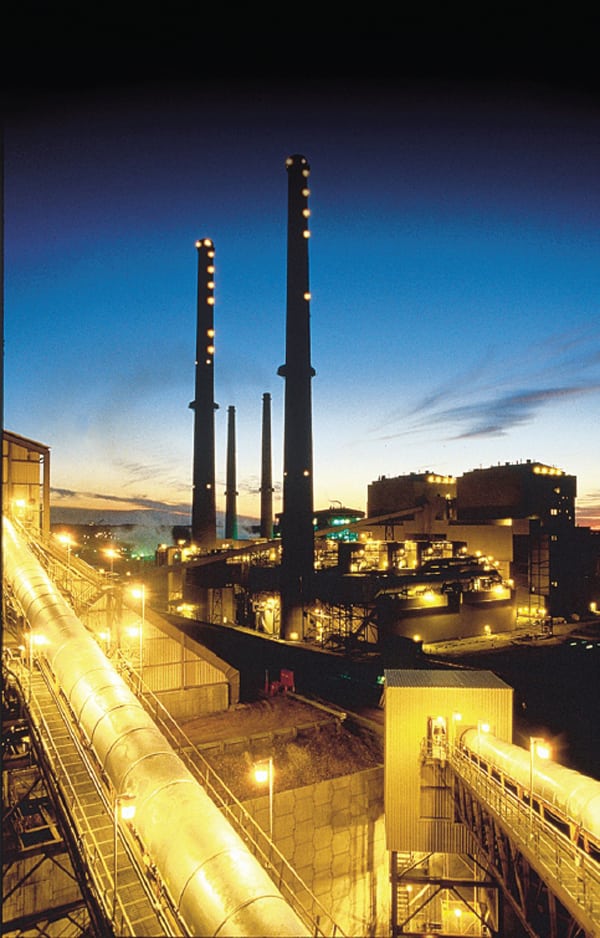The Environmental Protection Agency (EPA) on Dec. 21 issued its final Mercury and Air Toxics Standards (MATS), which will require about 40% of all coal-fired power plants in the U.S. to deploy pollution control technologies to curb emissions of mercury and other air pollutants such as arsenic and cyanide within three years. The regulation has been called the “most expensive order” aimed at companies that has been considered by the Obama administration.
The EPA also signed revisions to the new source performance standards (NSPS) for fossil fuel–fired electric generating units that revise the standards that new coal- and oil-fired power plants must meet for particulate matter (PM), sulfur dioxide (SO2), and nitrogen oxides (NOx).
A Mostly Unchanged Rule
The MATS rule was designed to reduce emissions of heavy metals—including mercury, arsenic, chromium, and nickel—and acid gases, including hydrochloric acid and hydrofluoric acid.
The final MATS rule is mostly unchanged from its March-issued proposal. The EPA said it "used new information from the public comment process to adjust some aspects of the rule," but the approach remains the same. Key changes: some emission limits are adjusted, including using filterable particulate matter (PM) as a surrogate for the metal toxics limit; a revised definition of coal subcategories; improved monitoring provisions for clarity; and an alternative compliance option for sources that plan to comply by averaging across multiple units.
Under the rule, all power plants will have to limit their toxic emissions, preventing 90% of the mercury in coal burned from being emitted into the air. Numerical emission limits are also set for PM (as a surrogate for toxic non-mercury metals) and hydrochloric acid (a surrogate for all toxic acid gases). The standards set work practices, instead of numerical limits, to limit emissions of organic air toxics, including dioxin/furan, from existing and new coal- and oil-fired power plants. The work practice standards essentially require an annual performance test program for each unit that includes inspection, adjustment, and/or maintenance and repairs to ensure optimal combustion.
The revisions to the NSPS for fossil fuel–fired units include revised numerical emission limits for PM, SO2, and NOx.
The EPA claims that the standards can be met with a “range of widely available and economically feasible technologies, practices and compliance strategies [that] are available to power plants to meet the emission limits, including wet and dry scrubbers, dry sorbent injection systems, activated carbon injection systems, and fabric filters.”
Compliance in Four Years
All coal- and oil-fired electric generating units with a capacity of 25 MW or more will be required to comply with MATS within the standard three years. But the EPA left the door open for extensions, saying it was “encouraging permitting authorities to make a fourth year broadly available for technology installations—and if still more time is needed, providing a well-defined pathway to address any localized reliability problems should they arise.”
Heeding concerns about unrealistic compliance timelines, the EPA said that it had maximized “flexibilities under the law” when promulgating the standards, ensuring that they abide by a Presidential Memorandum that directs the EPA to use tools provided in the Clean Air Act to implement MATS in “a cost-effective manner that ensures electric reliability.”
Costs and Reliability
The EPA said that “power plants are the largest remaining source of several toxic air pollutants,” including arsenic, cyanide, and dioxin, and are responsible for half of the mercury and over 75% of the acid gas emissions in the U.S. About 1,100 coal-fired and 300 oil-fired power units at 600 power plants emit these pollutants in the U.S., the agency estimates.
“Today, more than half of all coal-fired power plants already deploy pollution control technologies that will help them meet these achievable standards. Once final, these standards will level the playing field by ensuring the remaining plants—about 40 percent of all coal fired power plants—take similar steps to decrease dangerous pollutants.”
In a March 2011 analysis released when the rule was proposed, the EPA estimated 11,440 MW of coal-fired capacity (.xls) would be required to retire. In revised figures, the agency (and the DOE) analysis shows about 4.7 GW would retire—“less than one half of one percent,” of all coal plants, it says. The EPA says the standard would save lives and create 9,000 more jobs as plants invest billions to install pollution controls. It has also emphasized public health benefits, stating that the rule could prevent 17,000 premature deaths from toxic emissions.
EPA estimates show that electricity rates are projected to stay “well within normal historical fluctuations.” The standards will result in relatively small changes—about 3%—in the average retail price of electricity, primarily due to increased demand for natural gas, the agency says.
Earlier this year, the EPA estimated the rule would cost $11 billion per year, but in a new “Regulatory Impact Analysis for the Final Mercury and Air Toxics Standards,” the agency finds that the projected annual incremental private costs of the final MATS rule to the power sector are $9.6 billion in 2015 (in 2007 dollars).
Industry estimates have been much steeper: American Electric Power (AEP), for example, this June claimed the rules would force it to shut down 11 power plants and cost the Ohio-based generator alone more than $8 billion. According to White House records, industry trade groups had met with White House officials as recently as Dec. 14 to address cost concerns and secure utilities more time to comply with the rule.
More Rules on the Horizon
The agency signed off on the final rule on Dec. 16 as was required by a Feb. 8, 2008 order by the U.S. Court of Appeals, D.C. Circuit. That decision removed power plants from the Clean Air Act list of sources of hazardous air pollutants. At the same time, the court vacated the Clean Air Mercury Rule (CAMR), requiring the EPA promulgate a new rule governing mercury emissions from power plants by Nov. 16, 2011. The agency proposed the Mercury Air Toxics Standards on March 16 to replace CAMR.
In October, the EPA opposed a motion filed by the Utility Air Regulatory Group and 25 states, which urged a federal court to delay finalization of the rule by one year. In a statement on its website, the agency said it had received 900,000 comments regarding the proposed rule, including about 20,000 unique comments. To review those comments, the EPA eventually agreed to a 30-day extension, making Dec. 16 the last date to sign off on the rules.
Reactions to MACT
The Environmental Protection Agency’s (EPA’s) issuance of its final MATS rule has provoked a range of reactions, including renewed concerns about its costs and impact on grid reliability.
Fitch: Rule Could Prompt Early Coal Unit Retirements
Most of the publicized power sector concerns have focused on reliability. The new rule could prompt retirement of about 4.7 GW of coal-fired capacity—or about 2% of the nation’s coal capacity—by 2015, the EPA conservatively estimated. But in a statement, global rating agency Fitch Ratings said the final rule could “likely lead to the early retirement of power plants” particularly in some regions of the U.S. “The number of retirements may be modulated by the amount of time state regulators provide the plants to comply,” the agency said, though it added it foresaw “some beneficiaries” from the rule’s publication.
Fitch had previously estimated that about 83 GW of coal capacity in 37 states (most that were units smaller than 400 MW and older than 40 years and concentrated in Pennsylvania, Ohio, Indiana, Illinois, and Michigan) were at risk of retirement over the next decade due to various EPA rules. After MATS was finalized, the agency said many units would be “retired more quickly” because retrofitting those plants was not financially compelling.
“The timing and nature of those retirements remain to be seen,” it said. “The EPA’s rules give state regulators some flexibility with respect to the compliance time line. Lawsuits are already afoot that may add to that time frame.”
The EPA’s final rule showed several “useful technical changes” from its original proposal, but the Obama administration was “underestimating the complexity of implementing this rule in such a short period of time, which can create reliability challenges and even higher costs to customers,” said Edison Electric Institute President Tom Kuhn in a statement. “The Administration is not using all the available authorities in the Clean Air Act to coordinate implementation, to ensure electric reliability, and to avoid excessive costs.”
Obama to Jackson: Promote Orderly Execution of Rule
In Washington, President Obama issued a presidential memorandum praising the new rules as a “major step forward in my administration’s efforts to protect public health and the environment,” but he urged EPA Administrator Lisa Jackson to also “[p]romote early, coordinated and orderly planning and execution” of the rules. This required coordinating with the DOE, the Federal Energy Regulatory Commission (FERC), state utility regulators, and regional transmission organizations to specifically “promote predictability and reduce uncertainty."
On the congressional front, Republican lawmakers continued pressing concerns of the rule’s potentially significant implications for grid reliability. Among them was Sen. Lisa Murkowski (R-Alaska), who announced she would begin drafting legislation to define a “safety valve” to ensure that EPA rules “adequately take reliability issues into account and can be generally applied fairly across the board.”
“Based on the analysis we’ve seen so far—and the information that EPA either would not or could not provide—I continue to be concerned about the potential threat this rule poses to the reliability of the nation’s electric grid,” she said in a statement. Murkowski has alleged that no joint task force had been formed between FERC and the EPA to examine reliability issues as FERC Chair Jon Wellinghoff had testified, faulting the EPA for “largely ignored requests” for the agency to work closely with FERC and reliability experts. “Indeed, in recently released internal e-mails, a FERC employee expressed frustration with trying to work with EPA, noting that ‘I don’t think there is any value in continuing to engage EPA on the issues,’” she said.
Meanwhile, Sen. Joe Manchin (D-W.Va.) called the new standards “yet another onerous rule by the EPA” that “completely ignores the devastating impact these regulations will have on jobs and our economy, not only in West Virginia but across this nation.” Manchin and Sen. Dan Coates (R-Ind.) have introduces the Fair Compliance Act, which he called “a commonsense, bipartisan piece of legislation that would create a fair timeframe to comply with new rules.”
The legislation would delay compliance of the Cross State Air Pollution Rule finalized in July 2011 by two years so it would take effect in 2015, not in a week, as the rule decrees. The bill also would require utilities to submit implementation plans to ensure compliance occurs. To safeguard the reliability of the electric grid and avoid brownouts, utilities would need to submit their implementation plans to the North American Electric Reliability Corporation (NERC).
In a statement, Manchin said he hoped “Congress will address these regulations, and take up the Fair Compliance Act as soon as possible, to prevent the potential loss of a million jobs, increased utility rates, and more damage to our economy.”
EPA Rules Are Increasingly “Politicized”
Several industry representatives also rallied against the cost of implementing the new standards. The EPA has predicted the regulation could cost the industry $9.6 billion annually and raise U.S. retail electricity prices by an average of 3.1% in 2015.
But Institute of Energy Research President Tom Pyle called into question the EPA’s cost-benefit analysis, saying that environmental regulation under EPA Administrator Lisa Jackson was of an “increasingly politicized nature.”
“EPA itself has said that the costs could be as high as $11 billion, and the benefits could be as low as $500,000 annually. Even then, the EPA has been double-counting benefits that are already happening because of other rules,” he alleged.
Ratings agency Fitch said it expected the financial impacts on issuers to vary: “Regulated investor-owned utilities and public power entities are expected to successfully recover costs related to environmental compliance, but merchant generators owning coal-fired generation may struggle to do so,” the agency suggested. Of generators who could benefit from the accelerated retirement schedule and anticipated higher power prices were those who were less reliant on coal-fired capacity, it added.
Analysts: Challenges to Rule Compound Uncertainty
Law firms analyzing the new standards agreed that the rules could increase uncertainty, specifically because the EPA would likely face legal opposition relating to several aspects of the final MATS rule. “For example, affected sources and industry groups are expected to challenge the rule in court, with the deadline for filing such petitions 60 days from the publication of the final rule in the Federal Register,” explained Britt Fleming and Marisa Hecht in a blog entry for Van Ness Feldman. “Among other issues, the final MATS rule will give litigants an opportunity to challenge EPA’s contested pollutant-by-pollutant standard-setting methodology.”
—Sonal Patel is POWER’s senior writer. This material first appeared in POWERnews.













